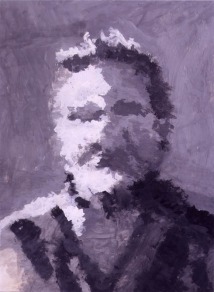http://www.livevideo.com/video/9A19F5F0E47B400EA5972433561AB02A/cllip-from-king-gimp.aspx
King Gimp

(Photo: The Success by Dan Keplinger. Retrieved from http://www.hbo.com/kinggimp/gallery/cmp/success.html)
On February 4th, the class had the opportunity to watch the Academy award winning film “King Gimp”. The film tells the story of Dan Keplinger. Dan was born with cerebral palsy. Filmmakers documented his life from age twelve into adulthood. The film was a moving depiction of a man’s commitment to the arts despite complicated and exasperating obstacles. Dan’s strength, focus, and courage permeate through the screen and are reflected in his artwork.
Initially, I did not know what to expect from the film. The class was not given a summary or any information regarding its content other than it was a film about a man who uses adapted equipment to paint. And for that I am grateful. His story is one all should see for themselves. His passion and his essence are in his art and the way he creates it. My response to this film was a dedication to my own creative identity and renewed willingness to bring this to my profession. It was a powerful film, and in the end I was in tears. As cliché as it is, Dan inspires me.
As I learn in class day in and day out about gross anatomy and clinical problems. It is easy to get lost in diagnosis and treating conditions as opposed to treating individuals. This film forced me out of that dazed pattern of learning. Dan’s disability may be why he uses the tools he does to paint, but in no way do they define Dan as a person or creative being. Dan paints because he enjoys it. He paints because he’s good at it. He paints as an extension of himself. For me, that’s the power of creative media.
In an interest to further understand the positive influence of art and health. I came across a website focused solely on the relationship of art and disability. It’s an Australian website and organization called Disability in the Arts/ Disadvantage in the Arts (DADAA) that provides art programs for community based, regional, institutional, and residential areas. The program addresses arts impact on aging, social participation, isolation, inclusion, and disability. The organization also has partnered with another organization to research the links between health and the arts. The website is a great resource for information on how to apply creative media within programs and offers articles and other sources of information that can benefit those seeking to understand the effectiveness of art in therapy.
Through “King Gimp” and the work produced by the DADAA, I have a greater appreciation for creative media and it’s influence and impact in the lives of those with special needs. I am adamant that occupational therapists must consider these factors when treating individuals and seek to understand the relationship between expressive media and health.
References
Arts and health. (2000-2009). Disability in the arts/ Disadvantage in the arts:
Western Australia [Resource]. Retrieved March 27, 2009, from
http://www.dadaawa.org.au/features/home-page-features/artsandhealth
HBO. (n.d.). The film. King Gimp. [Web page]. Retrieved March 27, 2009, from
http://www.hbo.com/kinggimp/king/index.html
